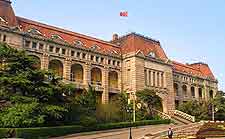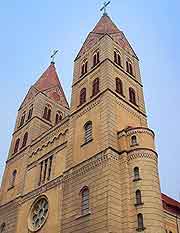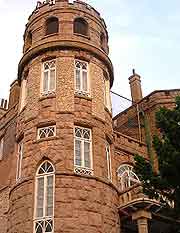Qingdao History Facts and Timeline
(Qingdao, Shandong, China)

The port city of Qingdao is one of China's leading centres of industry, naval power and sea trade. Situated on the Shandong Peninsula and overlooking the Yellow Sea, it is home to some of China's best known icons.
These landmarks include the Qingdao Haiwan Bridge, the lengthiest sea bridge in existence, and the Tsingtao Brewery, home of China's most popular beer. In 2009, it earned the title of China's most livable city.
Qing Defences
As the history of Chinese cities goes, Qingdao is a relative newcomer. It entered the limelight in 1891, when the Qing government started getting nervous about all the Western nations that were sniffing around the coast of China, looking for a way into this lucrative market. The Qing built up fortifications around Qingdao, but these defences were to prove of little use.
The Germans were the first to notice the new maritime fortifications and seized the port city. China then conceded the entire area to Germany in 1898 under the Kiautschou Bay concession, which gave the Germans control over Qingdao from 1898 until 1914. The German occupation is one reason the city's thriving beer industry exists today, along with many other examples of European influence.

German Influence
Qingdao is unique in China because the Germans held the city for so long. They transformed the Chinese fishing village into a modern city known as Tsingtao, building wide streets, installing a sewage system, and providing drinking water and electricity to the residents. During this period in history, schools in the city were among the best in China, and in general, Qingdao was a model of urban living for developing Asia.
The Germans opened the Germania Brewery in the year of 1903, which eventually became known as today's popular Tsingtao Brewery. During WWI, Germany based its East Asia Squadron of ships in Qingdao. However, it was unable to hold on to the city, losing out to the Japanese in 1914 when it declared war on Germany.

History of the 20th Century
The Japanese controlled Qingdao and much of the surrounding region until control of the city was reverted to the Republic of China in 1922. However, a further period of Japanese occupation occurred in 1938, with Chinese rule over the city established in 1949 under the People's Republic of China.
An Open Door Port City
In 1984, the Chinese government shifted towards an open-door policy to encourage foreign investment and trade with the country. Qingdao was chosen as a main port city for this purpose and it quickly grew into a major hub of industrial output, import and export. As modern China has slowly grown into the power that it is today, Qingdao has remained a vital port city for the government.
Nowadays it is home to China's northern naval fleet, but it also enjoys a solid tourism sector thanks to its festivals, pleasant climate and open attitude towards foreign visitors.
 The port city of Qingdao is one of China's leading centres of industry, naval power and sea trade. Situated on the Shandong Peninsula and overlooking the Yellow Sea, it is home to some of China's best known icons.
The port city of Qingdao is one of China's leading centres of industry, naval power and sea trade. Situated on the Shandong Peninsula and overlooking the Yellow Sea, it is home to some of China's best known icons.
